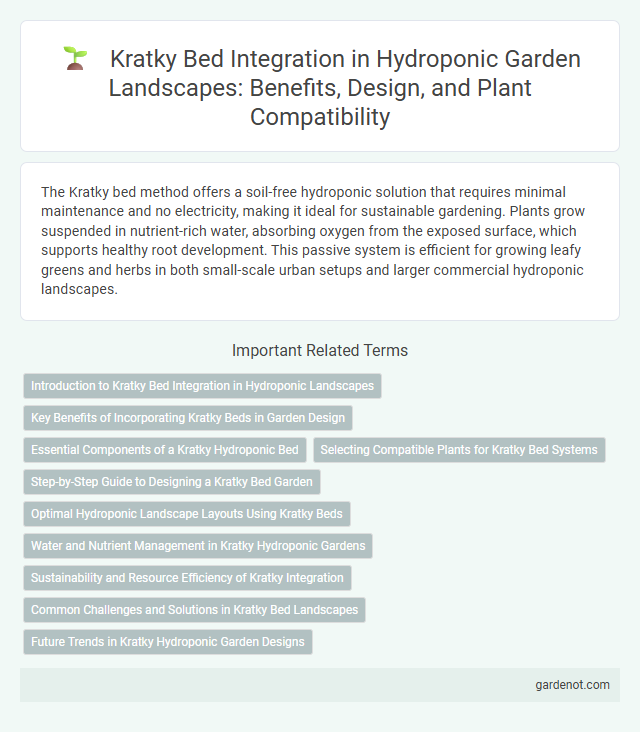The Kratky bed method offers a soil-free hydroponic solution that requires minimal maintenance and no electricity, making it ideal for sustainable gardening. Plants grow suspended in nutrient-rich water, absorbing oxygen from the exposed surface, which supports healthy root development. This passive system is efficient for growing leafy greens and herbs in both small-scale urban setups and larger commercial hydroponic landscapes.
Introduction to Kratky Bed Integration in Hydroponic Landscapes
Kratky bed integration in hydroponic landscapes offers a soil-less cultivation method that conserves water and nutrients by using a simple, passive system without pumps or electricity. This technique involves suspending plant roots in a nutrient-rich solution within a fixed reservoir, allowing roots to access oxygen as water levels decrease. Its low-maintenance design and scalability make the Kratky method ideal for sustainable urban farming and efficient space utilization in hydroponic landscaping.
Key Benefits of Incorporating Kratky Beds in Garden Design
Kratky beds revolutionize hydroponic landscapes by offering a soil-free, water-efficient growing method that drastically reduces water consumption compared to traditional gardening. This passive system requires no pumps or electricity, making it highly sustainable and cost-effective for diverse garden designs. Incorporating Kratky beds enhances crop yield and quality by maintaining optimal nutrient and oxygen levels, promoting faster plant growth and healthier produce.
Essential Components of a Kratky Hydroponic Bed
A Kratky hydroponic bed primarily consists of a non-circulating water reservoir, a growth medium such as coconut coir or clay pellets, and net pots to support the plants. The water reservoir must maintain an oxygen-rich environment by leaving an air gap around the roots, facilitating passive oxygen diffusion without the need for pumps or aerators. Proper sizing of the container and nutrient solution level is critical to support plant growth through the entire development cycle in a passive hydroponic system.
Selecting Compatible Plants for Kratky Bed Systems
Choosing compatible plants for Kratky bed systems involves selecting those with manageable root sizes and growth rates to prevent overcrowding and ensure optimal nutrient absorption. Leafy greens such as lettuce, spinach, and herbs thrive due to their shallow roots and quick harvest cycles, making them ideal candidates for passive hydroponic setups. Avoiding large or deep-rooted plants maintains water quality and nutrient balance, enhancing the efficiency and yield of Kratky hydroponic gardens.
Step-by-Step Guide to Designing a Kratky Bed Garden
Designing a Kratky bed garden begins by selecting a sturdy, opaque container to prevent algae growth and maintain water quality. Measure and drill holes in the lid to hold net pots securely, ensuring roots can access oxygen while submerged in the nutrient solution. Fill the container with a balanced hydroponic nutrient mix, place the seedlings in net pots, and monitor water levels regularly to maintain optimal plant growth without the need for pumps or aeration.
Optimal Hydroponic Landscape Layouts Using Kratky Beds
Optimal hydroponic landscape layouts using Kratky beds maximize space efficiency by strategically arranging multiple Kratky units to enhance plant density and airflow. Incorporating modular designs and tiered systems in the layout supports diverse crop varieties while maintaining nutrient solution stability without pumps. This approach reduces maintenance, conserves water, and promotes sustainable urban agriculture with minimal infrastructure.
Water and Nutrient Management in Kratky Hydroponic Gardens
Kratky hydroponic gardens utilize a passive water and nutrient management system where plants grow in a nutrient-rich water solution without active pumping or aeration. The water level gradually decreases as plants consume nutrients and water, creating an air gap that provides oxygen to the roots. Maintaining optimal nutrient concentration and water volume from the initial setup is critical to prevent nutrient deficiency and ensure healthy plant growth throughout the crop cycle.
Sustainability and Resource Efficiency of Kratky Integration
Kratky bed hydroponic systems enhance sustainability by eliminating the need for continuous water circulation, reducing energy consumption compared to traditional hydroponics. This passive method minimizes resource inputs, enabling efficient water and nutrient use with minimal waste. Integrating Kratky beds into hydroponic landscapes promotes eco-friendly cultivation by conserving water and lowering operational carbon footprints.
Common Challenges and Solutions in Kratky Bed Landscapes
Common challenges in Kratky bed landscapes include nutrient depletion, water evaporation, and insufficient oxygen supply to plant roots. Regular monitoring and timely replenishment of nutrient solutions help maintain optimal growth conditions, while covering the water surface with a light-blocking material reduces evaporation. Incorporating aeration techniques or designing deeper reservoirs enhances oxygen availability, ensuring healthy root development in hydroponic systems.
Future Trends in Kratky Hydroponic Garden Designs
Future trends in Kratky hydroponic garden designs emphasize automated nutrient management systems integrated with IoT sensors to optimize plant growth without manual intervention. Innovations include modular, scalable bed structures using eco-friendly materials that enhance water retention and root aeration for urban and vertical farming applications. These advancements aim to increase crop yield efficiency while reducing resource consumption in sustainable hydroponic landscapes.
Kratky bed Infographic

 gardenot.com
gardenot.com